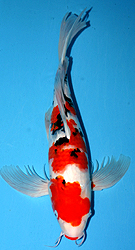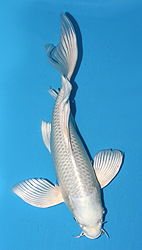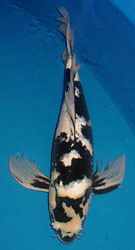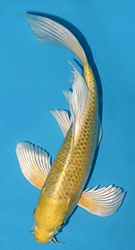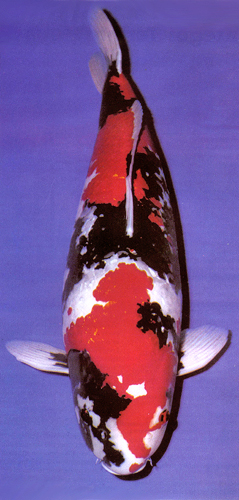Hirenagagoi Controversy is the spice of any hobby; it stimulates the ebb and flow of interaction and ideas and becomes a catalyst for change. The old guard often fears change as it represents a departure into the unknown, beyond the borders of the familiar, beyond the comfort zone. When innovation comes along, the new wave is often created by a quiet, grass roots movement, which over time can become an irresistible force. This seems to have been the case with Hirenagagoi in the United States. First let’s start with the name. The Japanese breeders who first created these animals named them Hirenagagoi, a compound word consisting of the three Japanese characters: Hire (meaning “Fin or Fins”) Nagai (meaning “Long”) Koi (meaning “Carp” or “Koi”) In English they have been called Butterfly Koi, High Fin Koi, Dragon Koi, and Longfin, but pretty much everyone can agree that the correct translation of the Japanese “Hirenagagoi” is Longfin Koi.
Hirenagagoi made quite an impact in Japan when they appeared on the scene in the eighties, but they disappeared just as quickly when the powers that be decreed them ineligible to be shown in Japanese koi shows. So when I first sought out Longfin Koi in Tokyo in 1989, the only Japanese Longfin breeder that I could track down was Atsushi Suda who had ceased breeding Longfin because there was virtually no market for them in Japan. With interest in Japan at less than zero, there was little or no incentive for any Japanese breeder to invest any time or effort in further developing these varieties. Thus began a long dry spell for Longfin from Japan. Here in the United States, however, Longfin have enjoyed a steadily increasing following of enthusiasts who are just as passionate about their Longfin as they are with their Nishikigoi. This American passion for beauty and innovation has been the driving force in creating an irresistible demand, which has in turn sparked a rebirth of Hirenagagoi breeding in Japan. Last fall, in Niigata alone, I counted five relatively major breeders breeding what they refer to as "Hirenagagoi" or Longfin Koi and every year there seems to be another breeder joining their ranks. Every Longfin breeder that I know of in Japan, sells out of his entire Longfin stock long before the end of each season with the major portion being shipped to the United States. As demand for Longfin increases, the pressure to increase supply pushes more breeders into the market and provides an impetus to create better quality and different varieties in an effort to distinguish their product from the competition. The result is a win-win situation for everyone involved. The breeders are forced by demand to produce higher quality specimens which fetch better prices, and the hobbyist gets access to a wider variety and a better quality animal.
In the not so distant past, many Longfin suffered from the two distinctly deficient body styles, long and skinny ( like Matsunosuke Sanke), or somewhat pot-bellied like goldfish. These genetic deficiencies have been corrected by knowledgeable and dedicated breeders, who have incorporated proven Nishikigoi bloodlines in their breeding programs. Japanese breeders have also recognized the value of hybrid vigor. Incorporating Longfin bloodlines into their standard Nishikigoi bloodlines has resulted in healthier, faster growing koi, that are capable of maintaining their body conformation as they reach sizes in excess of thirty inches. Nowhere is this more evident than in the spectacular Shinoda Ginrin Showa that won Grand Champion at the 1999 Niigata Nogyosai Koi Show This koi is now the backbone of Shinoda’s Ginrin Showa breeding program and both this koi and all of Shinoda’s massive Hi Utsuri owe their heritage to the Longfin Hi Utsuri originally created by Suda. While Nishikigoi are specifically bred to viewed primarily from the top, Longfin Koi bring a third dimension to the hobby in that they are often just as appealing when viewed from the side. This type of viewing exposes all aspects of the animal's anatomy to the viewer's scrutiny. On the subject of Hirenagagoi,Yukio Haibara, former Director of the All Japan Nishikigoi Promotion Association, put it aptly when he said, “It is truly a pity that Japan has failed to see the opportunity that these elegant creatures present for the expansion of the appreciation of Nishikigoi. Hopefully they can come to be accepted just as the Doitsugoi became accepted after much initial resistance.” There is no question that the quality of Hirenagagoi has improved by leaps and bounds in the last ten years and although they are still not accepted in koi shows in their land of origin, you will find a Longfin category in nearly every koi show in the United States. Regardless of where our personal preferences lie, there is no question that in the United States Longfin Koi are here to stay. So, in the immortal words of Rodney King, “Why can’t we all just get along?’ Comments from the Breeders
BACK TO TOP |
||||||||||||||||||
|
|
||||||||||||||||||

